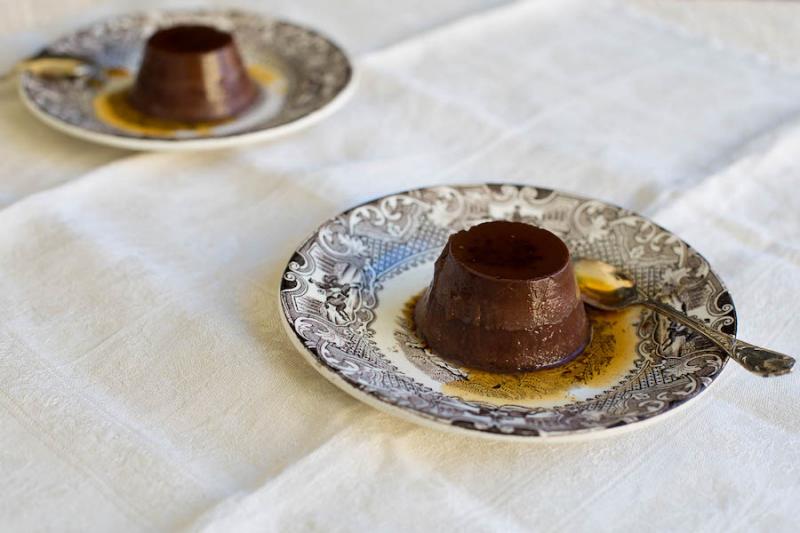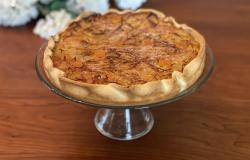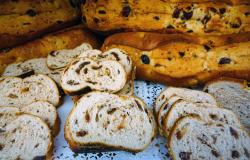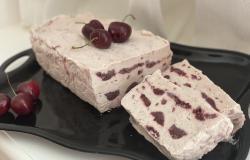Bonet (Piedmontese Chocolate and Amaretti Biscuit Flan)

If I were to nominate the dessert visitors are most likely to come across on a Piedmontese restaurant menu, it would definitely be a flan that goes by the name of bonet. Perhaps the best way to describe this dolce al cucchiaio or spoon dessert is to compare it to its transalpine cousin (and other restaurant favourite), the crème caramel. Both are prepared by beating eggs with sugar and milk. Both are poured into caramel-coated moulds and cooked in a bain-marie. Both can be prepared in advance and are extremely convenient for home and professional cooks wanting to whip up components of a multi-course meal well before their guests/patrons arrive. The difference: the bonet also includes cocoa and crushed amaretti biscuits. The latter, while baking, float to the top and form a crust which contrasts beautifully with the silky custard below.
Thought to have originated in the vine-covered hills of the Langhe, this sublime dolce's name means 'hat' in Piedmontese. The hat is generally thought to be the copper mould shaped like the bonèt ëd cusin-a (‘chef’s hat’) it was traditionally served in. Others, however, believe the name refers to the fact that bonet was served to conclude a meal, just as our hats would be the last thing to put on before heading home after a hearty meal at a friend’s home.
Like with other baked custards, avoiding egg-coagulation is essential to making a bonet with a smooth, silky interior. This can be done with an oven-based bain-marie or hot water bath. You won't need any fancy equipment for this. Simply find a baking dish with high sides and enough room to fit your mould/s. After filling your mould/s with the caramel coating and the custard, pour hot (not boiling) water in the surrounding dish until about two-thirds of the way up the mould/s. Despite an oven temperature of 160 ° C, the water will moderate the oven heat to well below boiling point as it evaporates.
Another important point regards one of the ingredients. The amaretti you'll need to make your bonet are those crisp and macaroon-like biscuits made with bitter almonds or apricot kernels, whipped egg whites and sugar, generally referred to as Amaretti di Saronno. Don't confuse these with Amaretti di Sassello, their chewier, marzipan-like counterparts. As for Amaretto di Saronno, that's a liqueur!
In the recipe below, I've indicated measurements for 8 individual moulds. Let's just say it's my way of ensuring I'm not tempted to second or third helpings of this dessert! You could, however, use one large pudding or loaf tin mould instead. If doing so, you'll need to extend the cooking time to about an hour. At any rate, use the time indicated below as a guideline, not a rule set in stone. Look out for a set mixture that still has a slight wobble in its centre. Also, a common alternative to the shot of rhum is some strong espresso coffee. It's simply a matter of personal taste. By adding rhum, you'll accentuate the sweetness of this flan whereas coffee will offset it slightly. Ognuno il suo gusto (Each to their own!) as they say in Italian!
Ingredients (makes about 8 individual moulds with a 125 mL capacity)
Preheat oven to degrees 160 ° C.
Add caster sugar to a long-handled, shallow, heavy-bottomed saucepan. Add water and lemon juice. Cook on low to medium heat. Swirl saucepan gently to ensure sugar is cooking evenly. After the sugar dissolves completely and begins boiling, the syrupy liquid will begin to change colour. Continue to cook until the caramel is foaming and a dark amber colour. Quickly distribute caramel inside the moulds, swirling to coat the bases. Leave to cool and set.
Take another heavy-bottomed saucepan and heat milk and bring to a simmer. Turn off heat and set aside.
In a large mixing bowl whisk whole eggs and sugar together until just combined. Add sieved cocoa powder, crushed amaretti biscuits and rhum. Once well combined, add heated milk and continue to stir gently. Distribute mixture evenly inside the caramel-coated moulds arranged in a baking tray. Fill tray two-thirds of the way up with hot water. Cook in bain-marie for 40-45 minutes or until the custards have set but still have a slight wobble in the centre.
Remove bain-marie from oven and allow to cool completely. Transfer bonet moulds from baking tray, cover and place in the fridge. Allow to set and cool for at least three hours or better yet, overnight.
Insert knife between the edge of each mould to make extracting the bonets easier. Place serving dish on top of mould and turn upside down. Carefully lift mould. Serve coated with as much caramel sauce as you can extract from the mould. Buon appetito!






